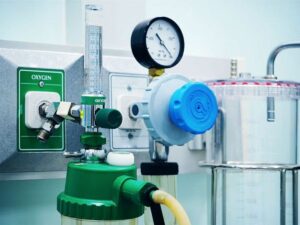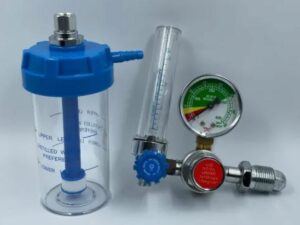Hyperbaric oxygen therapy (HBOT) is an innovative treatment approach that involves immersing the patient in a high-pressure environment and supplying them with pure or high-concentration oxygen at the same pressure level. Ensuring safe oxygen levels in the therapy chamber is vital to prevent risks of spontaneous combustion at 25-35% concentrations and explosions beyond 42%.
This article explores the causes and nursing measures for excessive oxygen concentration in the HBOT cabin
1. Understanding the Causes
Oxygen Delivery Pipeline Leaks
The oxygen delivery pipeline in the cabin comprises the respirator’s connecting pipe, the oxygen supply and exhaust pipe, and the breathing three-way pipe connected to the mask or the tracheal tube port. Various issues like malfunctions, improper usage, aging, and pressure vessel complications can all lead to oxygen leakage.

Impact of Oxygen Inhalation Mode
Two oxygen inhalation methods exist in an air-pressurized cabin: lung oxygen supply and continuous oxygen supply. The latter significantly impacts the cabin’s oxygen concentration, particularly when there are multiple users. In tracheostomy patients with high sputum or strong airway reactions, using a hood for oxygen inhalation is typically preferred, despite potential leak-induced oxygen concentration risks.
Improper Mask Usage
Using a sealed, valve-type mask is standard for lung oxygen supply. However, an improperly sealed mask can cause high oxygen concentrations in the cabin. Factors influencing this include the user’s age, facial structure, presence of nasogastric or nasojejunal tubes, and behavioral restlessness. Increased respiratory pressure in young and elderly patients may result in unsealed masks and oxygen leakage.
Oxygen Exhaust Valve and Oxygen Flow Meter Mismanagement
For stable oxygen inhalation during HBOT, opening the oxygen exhaust valve is necessary. This ensures that exhaled gases are expelled from the cabin, thus controlling the oxygen concentration. Missteps in the operating procedures, such as not fully opening the oxygen exhaust valve or not closing the emergency oxygen supply flow meter during continuous oxygen supply, can lead to excessive oxygen concentrations.

2. Implementing Effective Countermeasures
Strict Adherence to Equipment Safety Management
Ensuring the hyperbaric oxygen chamber’s optimal operation is pivotal for the safety and effectiveness of HBOT. Implementing standard operating specifications, treatment plans, and equipment inspection and management systems can greatly mitigate the risks. Regular oxygen chamber inspections and proper flow rate adjustments can help avoid potential issues.
Choosing the Right Oxygen Inhalation Method
The method of oxygen inhalation should be selected based on the treatment requirements and the patient’s condition. For elderly, frail, or comatose patients with breathing disorders, a continuous oxygen supply is recommended, with the flow rate adjusted to approximately 500-600 L/h. Tracheotomy patients should use a balloon connection tube for oxygen inhalation, given its superior seal and lower oxygen leakage risk.
| Method |
Indications |
Oxygen Concentration (%) |
Advantages |
Disadvantages |
| Nasal Cannula |
Mild hypoxemia, Comfort for longer use |
24-40 |
Comfortable, allows eating and speaking |
Not for severe hypoxemia |
| Simple Face Mask |
Short-term therapy, transport |
35-50 |
Simple to use, more O2 than nasal cannula |
Can be uncomfortable, not precise |
| Non-rebreather Mask |
Severe hypoxemia |
Up to 90 |
High O2 concentration, reservoir bag to ensure O2 supply |
Requires high O2 flow, may cause CO2 retention |
| Venturi Mask |
Need for specific O2 concentration |
24-60 |
Precise O2 concentration delivery |
More complex, needs proper mask size |
| High-flow Nasal Cannula (HFNC) |
Acute hypoxemic respiratory failure |
Varies, can be >90 |
Heated and humidified, comfortable |
Needs special equipment |
Enhancing Knowledge of Hyperbaric Oxygen Therapy
Successful HBOT depends on whether the patient can effectively inhale oxygen. Clear communication of the purpose, methods, and safety measures of HBOT can help alleviate patient and family anxiety. Patients with limited self-care abilities should have a companion present. Healthcare professionals should ensure the appropriate mask fit and guide patients on correct usage and breathing techniques.
Rigorous Monitoring of Oxygen Concentration
During steady-pressure oxygen inhalation, the oxygen concentration in the cabin should be strictly monitored. The indication value error on the oxygen meter should not exceed ±3%, and an alarm signal should be triggered if the oxygen concentration surpasses 23%, with the alarm error not exceeding ±1%.
Conclusion
Excessive oxygen concentration in hyperbaric oxygen therapy cabins is a significant safety concern. It can occur due to factors like oxygen delivery pipeline leakage, incorrect oxygen inhalation method, improper mask usage, unopened oxygen exhaust valve, and unclosed oxygen flow meter. Through the adopted safety measures, healthcare professionals can minimize risks, ensuring safe hyperbaric oxygen therapy.


